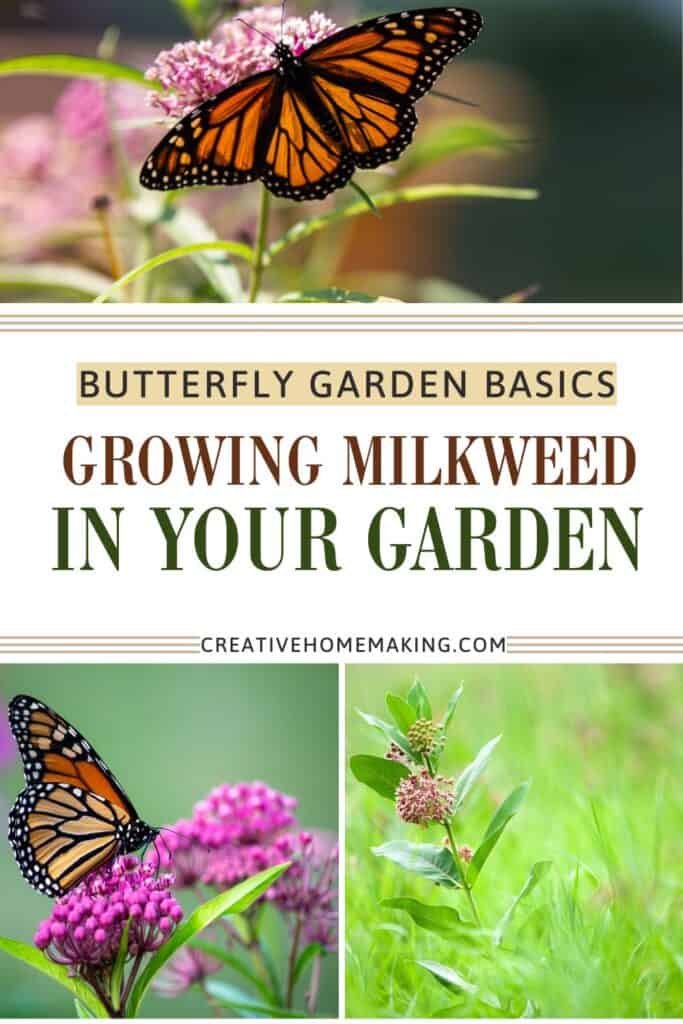If you want to create a butterfly garden that truly supports monarch butterflies, planting milkweed is essential. Milkweed is the only plant where monarch caterpillars can survive and grow. Growing milkweed in your butterfly garden helps provide food and habitat for these butterflies, which are facing habitat loss in the wild.
This post may contain affiliate links.
Milkweed also offers beautiful flowers that attract other pollinators, adding more life and color to your garden. By choosing the right varieties and planting them well, you can create a healthy environment for monarchs and other wildlife.
This guide will help you understand how to grow milkweed successfully, so your garden becomes a welcoming space for butterflies and a small part of their survival.
Related Article: How to Grow Verbena for a Butterfly-Friendly Garden

Choosing and Planting Milkweed Varieties
To grow milkweed successfully, you need to pick species that suit your area and prepare the right conditions for planting. How and where you plant milkweed affects its growth and how well it supports monarch butterflies.
Related Article: Top 11 Butterfly-Friendly Plants for Your Garden
Selecting the Right Milkweed Species
Choose milkweed species native to your region. Native plants are better adapted to local climate and soil. Look for species that meet your garden’s sunlight and moisture levels. For example:
- Common Milkweed (Asclepias syriaca): Grows well in full sun and average soil.
- Swamp Milkweed (Asclepias incarnata): Thrives in moist, wet soils.
- Butterfly Weed (Asclepias tuberosa): Prefers well-drained, dry soils.
Avoid tropical milkweed in cooler climates, as it can affect monarch migration. Using native varieties helps monarch larvae feed and grow properly.
Related Article: Why Butterfly Bushes Are a Must-Have for Butterfly Gardens
Preparing Soil and Garden Location
Milkweed likes well-drained soil and full sun. Pick a spot with at least 6 hours of direct sunlight daily. Avoid areas with heavy shade or constant wetness, unless the species prefers wet soil.
Clear the soil of weeds and loosen it to about 8 inches deep. If your soil is poor, mix in compost to improve texture and nutrients. Good soil promotes strong growth and helps milkweed withstand pests and drought.
Check moisture needs per species; some tolerate dry soil, while others prefer moist ground. Proper site preparation sets your plants up for long-term success.
Related Article: Why Creeping Phlox is the Perfect Plant for Butterfly Gardens
Planting Milkweed Seeds or Plants
You can start milkweed from seeds or young plants. For seeds, cold stratify them by chilling in a moist place for 30 days before planting. This process mimics winter and helps seeds sprout.
Plant seeds about 1/4 inch deep in well-prepared soil in early spring or fall. Keep the soil moist until seedlings appear.
If using nursery plants, space them 12 to 18 inches apart. Water regularly in the first weeks to help roots establish. Avoid overwatering after plants grow to reduce disease risk.
Use mulch around plants to keep soil moist and reduce weeds but keep it away from stems. This helps your milkweed thrive and support monarch butterflies well.
Related Article: How to Grow Black-Eyed Susans for a Butterfly-Friendly Garden
Supporting Butterfly Life Cycles
To support butterfly life cycles, you need to create the right environment for monarchs, take care of milkweed plants properly, and provide protection for butterflies. Each step ensures monarchs can thrive from egg to adult in your garden.
Creating a Suitable Habitat for Monarchs
Monarch butterflies need milkweed for laying eggs and feeding caterpillars. Plant at least 10 healthy milkweed plants in a sunny area with six or more hours of direct sunlight.
Make sure the space has good soil drainage and some nearby flowers for adult butterflies to get nectar. Leaving wild areas or shrubs for shelter helps protect monarchs from wind and predators. A garden around 100 square feet can support a small monarch population.
Avoid using pesticides or herbicides. They are harmful to the butterflies and their larvae. You want your garden to be a safe place for monarchs at all stages.
Related Article: When to Plant Sunflowers: A Simple Guide for Thriving Blooms
Promoting Healthy Growth and Maintenance
Milkweed needs well-drained soil and moderate watering. Avoid overwatering to prevent root rot. You can add mulch around plants to keep the roots cool and reduce weeds.
Cut back your milkweed in late fall or early spring to encourage new growth. Monitor for pests like aphids but avoid using chemical treatments. If pests appear, you can remove them by hand or spray the plants gently with water.
Healthy plants produce more leaves for caterpillars to feed on and strong stems to support eggs and larvae. Regularly check the condition of your plants and remove any dead or diseased parts.
Attracting and Protecting Butterflies
Besides milkweed, plant a variety of nectar flowers that bloom at different times to provide food throughout the butterfly season. Good options include coneflowers, lantana, and butterfly bushes.
Place flat stones or shallow water dishes nearby to give butterflies places to bask and drink. Avoid disturbing the area during breeding times to help protect eggs and caterpillars.
Using natural barriers like garden fences or companion plants can keep predators away. Creating a quiet, sheltered spot will encourage butterflies to stay and complete their life cycle in your garden.
Follow my Butterfly Garden board on Pinterest.




